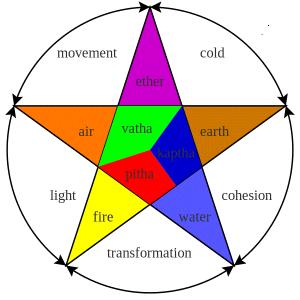Yoga and Ayurveda come from the same root (Samkhya) and both go along the same path.
Yoga is the science of self -discovery and the realization of the True Self and Ayurveda is the science of life and is focused on achieving a healthy life through correct diet etc.
According to the Ayurvedic System the whole universe is made up of the following five elements:
Ether (space)
Air
Fire
Water
Earth
These five elements exist in all matter & within each individual.
They manifest in the human body as 3 basic principles or humours known as tridosha.
The 3 Tridosha’s
- Vata …………….ether & air
- Pitta ……………fire & water
- Kapha………….water & earth
Vata
( Movement )
Vata is the energy that governs all biological movements. It governs breathing, eyes blinking, muscle movements, the heart beating & so on. It also governs feelings & emotions like creativity & flexibility on the positive side and anxiety, nervousness & fear on the negative side.
Pitta
( Transformation)
Pitta governs all the processes of transformation in the body such as digestion, absorption & assimilation of food in the body. It’s in charge of metabolism, body temperature & skin colour as well as being responsible for the digestion of thought. Psychologically pitta arouses courage, intelligence & get up & go on the positive side and anger, hate & jealousy on the negative side.
Kapha
(Stability)
Kapha cements all the elements in the body. It lubricates the joints, provides moisture to skin and gives biological strength, vigour & stability. Psychologically it’s responsible for the emotions of caring & forgiveness on the positive side and attachment & greed on the negative side.
The combination of these three doshas will determine the individual constitution called Prakruti. Knowledge of the Prakruti is the basis of Ayurvedic healing. Disease is borne when there is an imbalance of the doshas. Knowing & understanding your prakruti helps us to live in a way that there will be no imbalance.
The constitution is determined by which is the dominant dosha & can be either:
- Vata
- Pitta
- Kapha
- Vata – Pitta
- Vata – Kapha
- Pitta – Kapha
- Vata – Pitta – Kapha
Depending on the amount of each dosha is present in a person.
Characteristics of the 3 Main Constitutions
Vata Types
Physical; – Generally too tall or too short, with curly hair, scant thin eyelashes, lustreless eyes, rough & brittle nails, dry skin and with variable digestive power. Vata types are light sleepers often suffering with insomnia. They are prone to constipation & gas as well as disorders involving pain such as headaches to chronic diseases such as arthritis. Vata types are usually physically active and energetic.
Psychological; – They have a quick and agile mind, can be talkative, intellectual & can understand many points of view. Usually they are indecisive & unsteady lacking in determination & self -confidence often suffering from fear, worry & anxiety.
Pitta Types
Physical; -They are usually of average height & build with oily skin which is prone to acne, rashes & other inflammatory conditions. Their eyes are also easily inflamed. They usually have a good appetite, are prone to hyperacidity, ulcers and hypertension. They can suffer from fevers, infections, toxic blood conditions as well as inflammation.
Psychological;- Generally they are intelligent & able to understand arguments quickly. They have a sharp & agile mind & can assimilate different concepts and ideas. However they can also be opinionated, judgemental, critical, self righteous & prone to anger.
Kapha Types
Physical; – Usually shorter than average height, they possess a well-developed body & have a tendency to carry excess weight. They have soft skin & large, attractive eyes. They possess a low but constant appetite with a slow metabolism. It’s usually quite difficult for Kapha types to lose weight.
Psychological:- Emotional in temperament they have a lot of love & devotion & are loyal. They can also be possessive & become attached to people or things easily. They are slower at learning but retain what they’ve learnt well. They prefer stability & dislike change.
Food & Ayurveda
A diet that is based on one’s individual constitution should be chosen. Foods are divided according to tastes & in the ayurvedic system there are 6 main tastes that are derived from the five elements.
| Taste | Elements | Effects on dosha |
| Sweet | Earth & Water | +K -PV |
| Sour | Earth & Fire | +PK -V |
| Salty | Water & Fire | +PK -V |
| Pungent | Fire & Air | +PV – K |
| Bitter | Air & Ether | +V -PK |
| Astringent | Air & Earth | +VK -P |
Aggravate Vata Dosha
- Bitter
- Pungent
- Astringent
Aggravate Pitta Dosha
- Sour
- Salty
- Pungent
Aggravate Kapha Dosha
- Sweet
- Sour
- Salty
Good for Vata Dosha (decrease vata)
- Sweet
- Sour
- Salty
Good for Pitta Dosha (decrease pitta)
- Sweet
- Bitter
- Astringent
Good for Kapha Dosha (decrease kapha)
- Pungent
- Bitter
- Astringent

